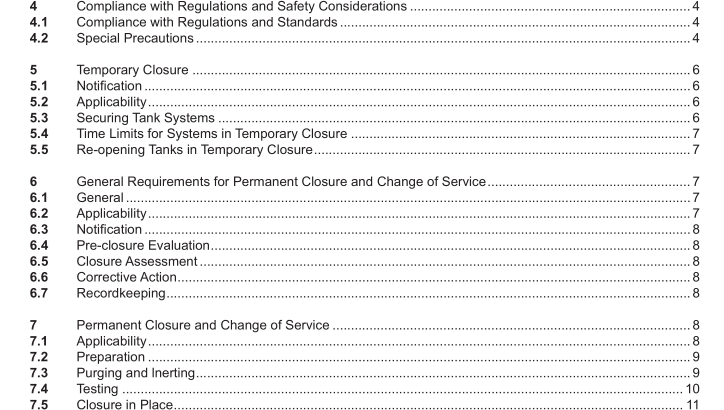API 1604:2021 pdf free download.Closure of Underground Petroleum Storage Tanks
4Compliance with Regulations and Safety Considerations4.1Compliance with Regulations and Standards
4.1.1 The closure in place,removal, storage,and off-site disposal of UST systems that have containedflammable or combustible fluids shall be accomplished in accordance with federal, state, and local requirements,this recommended practice, and accepted safety standards.
4.1.2 Before initiating work, the authority having jurisdiction(AHJ) should be notified and consulted concerningapplicable regulatory and permit requirements.
4.1.3 All applicable permits shall be obtained prior to beginning any work.Certified or licensed contractors maybe required in some states.Consult the AHJ for contractor requirements.Contractors, subcontractors, and theiremployees responsible for tank closure in place or removal shall be familiar with the following:
a) all applicable safety rules and regulations,including OSHA’s Occupational Safety and Health Standards (Title 29 CFR Part 1910);
b) the use of equipment and procedures for testing and vapor-freeing tanks;c) the handling and disposal of the types of wastes likely to be encountered; andd) the applicable sections of the publications referenced in Section 2.
4.2Special Precautions
During UST removal or closure in place,workers may be exposed to petroleum hydrocarbon liquids, vapors,or wastes.The precautions in 4.2.1 and 4.2.2 should be observed by all individuals engaged in the proceduresdiscussed in this recommended practice.
4.2.1 Toxicity Considerations for Petroleum Substances
4.2.1.1General
All personnel involved in the work shall be aware of appropriate health and safety precautions. When highconcentrations of petroleum hydrocarbon vapors are inhaled,symptoms of intoxication may result. Thesesymptoms, ranging from dizziness to excitement or unconsciousness, are similar to those produced by alcohol oranesthetic gases. lf such effects occur, the individual shall be removed to fresh air.For minor effects of exposure,breathing fresh air or oxygen results in rapid recovery. If breathing has stopped,artificial respiration shall beapplied promptly. Medical attention shall be obtained as soon as possible.Paragraphs 4.2.1.2 and 4.2.1.3 containspecial toxicity considerations for benzene and tetraethyl lead, which may be present in petroleum products orwastes found in or around USTs. Care shall be exercised to minimize exposure to these substances when theyare present during the handling of used underground petroleum storage tanks.
WARNING—Tests have shown that prolonged or repeated exposure to some petroleum substances in liquid orvapor form may cause serious illness, including cancer, in laboratory animals. Although the significance of thesetest results to human health is not fully understood, exposure to petroleum substances should be minimized.Thefollowing health precautions are suggested.
a)Avoid contact with skin and inhalation of vapors.
b) Keep petroleum liquids away from eyes, skin, and mouth; they can be harmful or fatal if inhaled, absorbed through the skin, or ingested.
c) Use soap and water or waterless hand cleaner to remove any petroleum product that contacts skin. Do not use gasoline or similar solvents to remove oil and grease from skin.
d) Promptly wash petroleum-soaked clothes and avoid using soaked leather goods, taking care not to expose to ignition sources.Properly dispose of rags.
e) Keep work areas clean and well ventilated.f)Clean up spills promptly.
4.2.1.2 Benzene
High occupational exposures to benzene have been associated with various human blood disorders, including anincreased risk of leukemia.Very high levels have also been known to affect the central nervous system. Benzeneadministered by mouth has induced cancer in laboratory animals in long-term tests. Benzene is rapidly absorbedthrough the skin. The Occupational Safety and Health Administration (OSHA) imposes limits on occupationalexposure and requirements concerning the communication of hazards to workers. See 29 CFR Part 1919.1000(Table A-2),Part 1910.1028, and Part1910.1200.All exposure limit values should be based on the most currentand stringent published industry and regulatory values.
4.2.1.3 Tetraethyl Lead
This organic form of lead can cause diseases of the central and peripheral nervous system, kidneys, and blood.Skin absorption of this compound is a major route of entry into the body. The ACGIH time-weighted average is0.1 mg/1 m3 for general room air.The TLV in oSHA’s Occupational Safety and Health Standards (29 cFR Part1910.1000,Table Z-1) is 0.075 mg/1 m3.
4.2.2 Flammability and Combustibility Considerations
4.2.2.1 Flammable or combustible vapors are likely to be present in the work area.The concentration of vaporsin the tank, excavation, or work area may reach the flammable or explosive range before venting is complete anda safe atmosphere is established.Therefore, the following precautions shall be taken:
a) Restrict or eliminate all potential sources of ignition from the area (for example, hot work smoking materials,
and non-explosion-proof electrical and internal combustion equipment).
b) Prevent the discharge of static electricity during venting of flammable vapors by bonding and grounding all
metallic parts, and ensure that all hoses, ducts, or other non-metallic components are either conductive orare bonded and grounded.API 1604 pdf download.API 1604:2021 pdf free download
